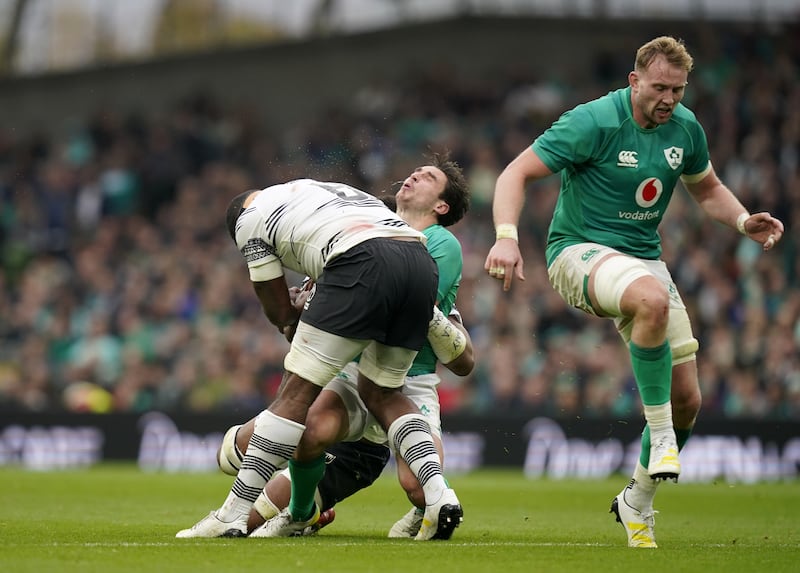Johnny Sexton threw the keys to number 10 to Joey Carbery for the week and when he got them back after Saturday’s win over Fiji, the Ireland captain will have found a little bit of a mess, several things out of place but nothing that a training pitch blitz on basics won’t sort out ahead of the next Test match against Australia.
That’s not exactly what this Irish team requires, though, in Sexton’s absence. It needs to be less safe, a little more edgy and those traits can’t be found in the pages of a playbook. He doesn’t seek sanctuary in being safe or conservative, so those who deputise need to bear that in mind.
Sometimes improvisation is required, that ability to scan the horizon and see the spaces, to react to the way that the opposition are defending and tweak the patterns accordingly, the ability to deceive, to make the defence stop and think, just pause for the split second that forces a disconnect and with it, prized access to the backfield.
It doesn’t always have to be orthodox or packaged in the form of a pre-planned gambit. There are times when it’s okay to be cavalier, whether running, passing or kicking. If a player never strays from the prescribed, he may never make a mistake, but he’ll never learn. Rugby is not chess with heavy strapping and gumshields.
Carbery was neat and tidy in most of what he did, one or two aberrations aside, a kick out on the full and an attempted grubber kick blocked the most conspicuous. There is an argument too that for the Fijians first try, the 27-year-old should have pushed up to fill the defensive line on the edge, aware that Jimmy O’Brien was covering the backfield and therefore any kick through.

By not doing so he left Jamison Gibson-Park to cover multiple players; it was a line break that could have been negated. Players must occasionally step outside the system and read the game on the fly.
Carbery is, like any outhalf, largely reliant on the workmanship of the pack in the platform provided for him to run the game.
He had to deal with a sizeable snag list, principally, that Ireland rarely broke the gain-line with any momentum, ball carriers resembled Easter Island statues, static and lacking animation, with most of the passing telegraphed, from tips-on to pivot, the intended receiver obvious.
Prop and debutant Jeremy Loughman and centre Stuart McCloskey operated on the front-line as primary receivers while Carbery lurked in the demilitarised zone behind the human screen. Fiji had proved capable students in analysing Ireland’s attack, pushing up and into Carbery’s running and passing zones.
It’s hardly a coincidence Ireland’s most effective line-breaks came from shaping to go out the back but instead passing short and flat to a player in the front-line.
In reflecting on the game there were two moments that stood out, as how Ireland should carry into contact, the first provided by the excellent Kieran Treadwell who came from depth and at pace to smash through the Fijian line, an outcome that replacement Max Deegan replicated later in the game. Caelan Doris was another who invariably made metres in contact.
Ireland’s maul was a lucrative source of points but there were times, seven minutes to be precise, when the home side faffed around in the Fijian 22 and it was then that Carbery needed to take a more hands-on role and direct his team-mates. There were a couple of occasions when forwards got in between him and his scrumhalf, neutralising the chance of quick ball.
It would be nice to see Carbery be more authoritative, take the game by the scruff of the neck, play with the swagger of old, back his footwork and his acceleration and trust the instinctive flair that made him so difficult to play against in those early days. Reading the autocue is perfectly adequate for the most part but there is a need to ad-lib and that’s what great players and outhalves can do.
Presence is so important for an outhalf and there were some interesting television pictures on 68 minutes where replacement outhalf Jack Crowley takes ownership of a huddle with the forwards; the 22-year-old on debut is the one doing the talking.
The former Bandon boy enjoyed some bright moments, improvised passes, showed quick hands, good footwork, and strength and even when he made a mistake by kicking it dead, he bounced into the next task.
For the second game in succession against Fiji Carbery was unfortunate to be clobbered; in 2017 he suffered a broken arm, this time he was the victim of an ugly, high, dangerous shot from Albert Tuisue which was correctly punished with a red card. He didn’t return from a HIA and will now have to go through the return to play protocols.
It’s not up to Carbery or Crowley to be versions or clones of Sexton. They are talented players in their own right but must bring that personality when given the opportunity. If the team is playing fitfully, they need to recalibrate the attack, find solutions, and communicate them in word and deed. The attitude can’t be that they are content to house sit and hand back the keys, if some day they want to own the gaff.
















